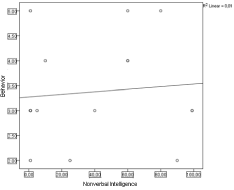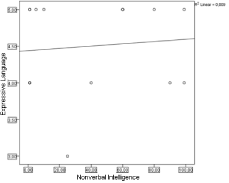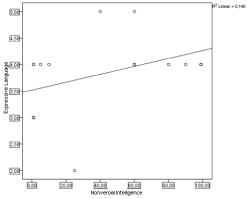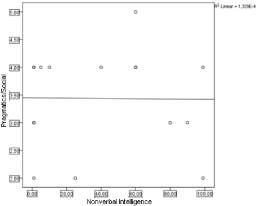
Research Article
Austin J Autism & Relat Disabil. 2016; 2(1): 1013.
Correlations between Nonverbal Intelligence and Communicative Abilities of Brazilian Children with Autism Spectrum Disorders
Thaís Helena Ferreira Santos¹, Cristina de Andrade Varanda¹, Milene Rossi Pereira Barbosa¹, Ingrid Ya I Sun¹, Cibelle Albuquerque de la Higuera Amato² and Fernanda Dreux M Fernandes¹*
¹School of Medicine – Universidade de São Paulo (USP)
²Universidade Presbiteriana Mackenzie
*Corresponding author: Fernanda Dreux M Fernandes, School of Medicine – Universidade de São Paulo (USP) Rua do manjericão 301, Cotia, SP – Brazil
Received: December 02, 2015; Accepted: January 14, 2016; Published: January 20, 2016
Abstract
Introduction: Autism is a lifetime disorder characterized by deficits on social interaction and communication and presence of a restrict repertoire of activities and interests. The difficulties in communication occur in varying degrees in children with ASD, both in verbal and non-verbal abilities. The purpose of this research was to verify the association between functional communicative disorders and non-verbal intelligence in children and teenagers with ASD.
Methods: Participants were 16 children diagnosed with ASD by psychiatrists, 12 boys and 4 girls with ages varying from 3:9 y and 14:8 y. The tests used were the Raven’s Colored Progressive Matrices Test–to assess the nonverbal intelligence–and the Functional Communication Profile–Revised and reduced–that assesses the areas of Behavior, Attention, Receptive Language, Expressive Language and Social/Pragmatics.
Results and Discussion: Results place 50% of the participants below the average line of non-verbal intelligence according to the Raven’s test. No significant associations were found between the results in non-verbal intelligence and the areas of the Functional Communication Profile.
Conclusion: These outcomes may be caused by the great variability of the phenotype of ASD and therefore, studies with larger samples and different assessment tools are suggested.
Keywords: Autism; Language assessment; Non-verbal intelligence
Abbreviations
ASD: Autism Spectrum Disorders; DSM-5: Diagnostic and Statistical Manual of Mental Disorders; FCP-Rr: Functional Communication Profile Revised and reduced; RAVEN: Raven’s Colored Progressive Matrices Test
Introduction
Autism is a lifetime disorder characterized by deficits in social interaction and communication and presence of a restrict repertoire of activities and interests [1]. It is a developmental disorder with no known biological markers; therefore the diagnosis is based on behavioral criteria [2]. Recently the American Psychiatric Association proposed changes in the classification of ASD, including them among the neuro developmental disorders and suggesting that the severity definition should be based on social communication impairments and behavioral disorders [3].
Several studies have aimed to identify, describe and present more efficient intervention proposals to symptoms of ASD [4]. From the many descriptions of autism, apparently the only point in which there is agreement among several authors is the attribution of a central role to language and communication disorders in the description of symptoms [5]. The functional perspective of language use takes into account, besides the functions and communicative means, the context in which communication happens. This perspective demands the inclusion of non-verbal communication in the assessment and intervention planning for children with ASD. Systematic assess of the communicative competence allows better understanding about the factors that interfere in the way children use their linguistics abilities [6].
The difficulties in communication occur in varying degrees in children with ASD, both in verbal and non-verbal abilities. A child with autism usually experiences considerable problems in speech and language, including delays in babbling and speaking, delays in learning how to use gestures, echolalia, lack of spoken language, social-interaction difficulties and communication challenges. These communication delays interfere with learning in everyday life [7]. Some children don’t develop other than the most basic communication abilities. Other children present immature language, characterized by the use of jargon, pronoun reversal, abnormal prosody, monotonous tone of voice and other disorders [8]. The language and communication deficits tend to persist through adulthood [8]. Those individuals that acquire verbal abilities can show persistent deficits in their capacity to establish and maintain conversation. These difficulties can result in lack of reciprocity, difficulties to understand language subtleties, jokes and sarcasm, as well as problems to understand body language and facial expressions [9].
The assessment procedures should aim the differential diagnosis andsupport the planning for intervention approaches that improve the communicative functionality [10]. The determination of assessment criteria to standardize the obtained data is very important to the success of the proposed therapeutic techniques [11].
The purpose of this research was to explore the association between functional communicative disorders - based on the answers to the FCP-Rr - and non-verbal intelligence – according to the RAVEN - in children and teenagers with ASD.
Materials and Methods
The study was submitted to the institution’s Research Ethics Committee and one caregiver (father or mother) of each of the participants signed the approved consent form.
Participants
A total of 16 participants diagnosed with ASD by psychiatrists, according to the criteria proposed by DSM-IVtr [12] and ICD-10 [13] participated in this study. Twelve of the participants were male and four were female, with ages varying from three years and nine months and fourteen years and eight months.
Inclusion criteria were: diagnosis within the autism spectrum made by psychiatrists and/or neurologists; fluent use of verbal communication for conversation; be available to cooperate and answer to the tests; attend weekly language therapy at the Speech Language Pathology Research Laboratory in ASD of the School of Medicine of Universidade de São Paulo (Brazil).
Schooling and social-demographic characteristics were not considered relevant to the sample characterization.
Material and Procedure
Two tests were used to verify the two variables (nonverbal intelligence and communicative abilities):
• Raven’s Colored Progressive Matrices Test [14]
This test was used for the evaluation of the nonverbal intelligence of the participants. In this test, the examiner shows a picture of a geometrical figure with a part missing in each item. The child’s task is to point to the figure of the part that would complete the main drawing, among six alternatives. The Raven’s Colored Progressive Matrices Test was administered individually, according to the guidelines presented in its manual and analyzed by a psychologist with appropriate experience.
• Functional Communication Profile – Revised and reduced [15]
This is a reduced protocol based on the FCP-R [16] that comprises the areas of Behavior, Attention, Receptive Language, Expressive Language and Social/Pragmatics that was validated to be used with Brazilian population.
This instrument was applied during an interview with the speech-language therapist of each participant. The scoring system was adapted from the original protocol. The questions of each area supply information that allow the commitment of a degree in each studied area. The test [16] proposes that this analysis should be made according to the personal impressions derived from the answers obtained and this was the procedure adopted in this study. With the aim of improving the instrument’s objectivity and avoid possible interferences due to personal impressions, the possible answers were graded according to the frequency and to the severity of the symptoms of the autism spectrum [17]. The scores assigned varied from zero to four points; zero was attributed to the best possible answer, and four to the worst possibility, or the most severe behavior and/or most frequent on the ASD. The scoring determined to each possible answer defined the minimum and maximum scoring for each severity degree. The severity possibilities are: normal, mild, moderate, severe and profound, with a specific scoring criterion for each severity degree.
Statistical analysis
The Spearman test was used to verify the possible correlations between variables. The significance level adopted was 0.05 (5%).
Results and Discussion
The data obtained at the RAVEN and at the FCP-Rr are described in (Table 1) and its analysis is presented thereafter.
Test
Minimum
Maximum
Mean
Std Deviation
Raven
Nonverbal intelligence
1.00
99.00
39.56
38.48
FCP-R (reduced)
Behavior
2.00
5.00
3.37
1.02
Attentiveness
3.00
5.00
4.00
0.73
Receptive Language
3.00
5.00
4.50
0.63
Expressive Language
2.00
5.00
3.81
0.75
Pragmatic/Social
2.00
5.00
3.44
0.89
Table 1: Descriptive Statistics.
In Raven, 37.5% of the subjects were classified as “intellectually disabled”, 12.5% as “definitely below average in intellectual capacity”, 25% as “intellectually average”, 12.5% as “definitely above average in intellectual capacity” and 12.5% as “intellectually superior”. In the FCP-Rr the percentage of subjects who had any deficit was: 93.75% for the domain behavior, 75% for attentiveness, 43.75% for receptive language, 87.5% for expressive language and 100% for pragmatic/ social. The scores adopted to classify the FCP-Rr answers were: profound-1, severe-2, moderate-3, mild-4 and normal-5.
Spearman test was used to verify the correlation between the results in the non-verbal intelligence test and each of the areas of the FCP-Rr. These results are described in (Figures 1,2,3,4,5) and its analysis presented thereafter.

Figure 1: Correlation between nonverbal intelligence and behavior.

Figure 2: Correlation between nonverbal intelligence and attentiveness.

Figure 3: Correlation between nonverbal intelligence and receptive language.

Figure 4: Correlations between nonverbal intelligence and expressive
language.

Figure 5: Correlations between nonverbal intelligence and pragmatic/social.
For the behavior domain, the correlation was positive (r=0.101), showing that the subjects who have minor behavioral difficulties have also major intellectual abilities, but this correlation was not significant (p=0.701). This kind of positive correlation was also found in the areas: receptive language (r=0.108) also not significant (p=0.690); expressive language (r=0.448) also not significant (p=0.082) and pragmatic/social (r=0.025) also not significant (p=0.926). For the attentiveness domain, there was a negative correlation (r=-0.049), with a weak correlation coefficient and also not significant (p=0,857).
Low nonverbal intelligence has been linked to structural language impairment in autism [18]. Mild language impairment and mild intellectual disability are sometimes connected. There are non-verbal individuals who show severe or profound cognitive impairments [18]. It is possible to infer that these studies on structural language impairment in ASD focus on children with higher IQs (the ones who can answer the tests) and thus this language impairment may differ qualitatively from language impairments in children with ASD with lower cognitive levels. There are also authors who found that language impairment co-occurs with autism independently of intellectual disability as measured by Performance IQ or Full Scale IQ. This heterogeneity has led to the widely accepted view of autism as a spectrum [18]. Other authors found that semantic and morphosyntactic abilities demonstrated no significant associations with nonverbal IQ [19].
Conclusions
In this study nonverbal intelligence of children with ASD was not significantly associated to skills such as: behavior, attentiveness, receptive language, expressive language and pragmatic/social. It is important to consider that the subjects of this research showed a considerably great dispersion between their performance and the average of the group concerning nonverbal intelligence with a standard deviation of 38.48, which leads to the idea that this is a heterogeneous group regarding nonverbal IQ. Also 100% of the subjects of this research showed pragmatic/social deficits and 93,75% showed deficits in behavior. In other words this is a group that varied in nonverbal IQ and showed a significant deficit in pragmatic/social skills. Taking these results into account, one may think that pragmatic/social skills do not necessarily relate to nonverbal IQ. On one hand, these results question cognitive referencing for intervening with specific language skills in autism and on the other hand corroborate the view of autism as a spectrum.
The most important limitations of this study are the relatively small sample size and the ample variation in chronological age. They are a result of the inclusion criteria, especially the need to present fluent verbal communication and to collaborate in the tests. The final number of participants was determined by the compliance with the inclusion criteria because the aim of the study wasn’t to determine the characteristics of any given test for this population but to explore the association between the results of both assessments.
Overall, considering the great variability of the phenotype of ASD and the age difference, studies with larger samples and/or using different assessment tools may yield to different results.
References
- Prelock PA. Autism spectrum disorders- Issues in assessment and intervention. Pro-ed, Austin, Texas. 2006.
- Hill EL, Frith U. Understanding autism: insights from mind and brain. Philos Trans R Soc Lond B Biol Sci. 2003; 358: 281-289.
- American Psychiatry Association. Diagnostic and statistical manual of mental disorder. 5th edition. Washington, American Psychiatric Association. 2013.
- Siller M, Morgan L, Swanson M, Hotez E. Promoting early-identification of autism in the primary care setting: bridging the gap between what we know and what we do. In Recent Advances in Autism Spectrum Disorders-Vol I. Fitzgerald M (ed). Intech Croatia. 2013.
- Fernandes FDM. Functional aspects of the autistic childrens communication. Temas Desenvolv. 2000; 9: 25-35.
- Cardoso C, Fernandes FD. Relation between social cognitive aspects and the functional communicative profile in a group of adolescents of the autistic spectrum. Pró-Fono R Atual Cient. 2006; 18: 89-98.
- Kaf WA, Barboa L, Abdelhakiem AK, Almomani MO. Autism Spectrum Disorders is on the rise: speech pathologists and audiologists must rise up to the challenges. Austin J Autism &Relat Disabil. 2015; 1: 1003.
- Melo TM, Saidah SH, Lopes-Herrera SA, Hage SVR. Relationship between central nervous system abnormalities and autism. Rev Cefac. 2006; 8: 36-41.
- Gadia CA, Tuchman R, Rotta NT. Autism and pervasive developmental disorders. J Pediatr. 2004; 80: 83-94.
- Fernandes FDM, Barbosa MRP, Santos THF, Amato CAH. Speech-Language Pathology in the Assessment and Diagnosis within the Autism Spectrum. In: Fitzgerald M. Autism Spectrum Disorders – Recent Advances. Intech. 2015.
- Fernandes FDM. Sugestões de procedimentos terapêuticos de linguagem em distúrbios do espectro autístico. In: Limongi SCO. Fonoaudiologia: informação para formação. Rio de Janeiro: Guanabara Koogan. 2003; 55-65.
- American Psychiatry Association. Diagnostic and statistical manual of mental disorders. 4th edition (text rev). Washington, American Psychiatric Association. 2000.
- Organização Mundial da Saúde. Classificação Estatística Internacional de Doenças e Problemas Relacionados à Saúde: CID-10 Décima revisão. Trad. do Centro Colaborador da OMS para a Classificação de Doenças em Português. 3 ed. São Paulo: EDUSP; 1996.
- Raven JC. Teste das matrizes progressivas escala geral - manual. Rio de Janeiro: Centro Editor de Psicologia Aplicada. 2008.
- Santos THF, Fernandes FDM. Comparizon between the Functional Communicative Profile and the answers obtained on the Functional Communication Profile - Revised (FCP-R) in children and adolescents of the autism spectrum. [dissertation]. São Paulo: University of São Paulo - School of Medicine. 2012.
- Kleiman LI. Functional Communication Profile - Revised. Lingui Systems. 2003.
- Santos THF, Fernandes FDM. Functional Communication Profile – Revised: uma proposta de caracterização objetiva de crianças e adolescents do espectro do autism. Rev Soc Bras Fonoaudiol. 2012; 17: 454-458.
- Williams D, Botting N, Boucher J. Language in autism and specific language impairment: Where are the links? Psychol Bull. 2008; 134: 944-963.
- Dethorne LS, Watkins RV. Language abilities and nonverbal IQ in children with language impairment: inconsistency across measures. Clin Linguist Phon. 2006; 20: 641-658.